Tuesday, 27 April 2010
Main Exercise - Final Cut
Above is the final and edited cut for our small Media Studies project film.
Tuesday, 20 April 2010
Any use of music in this film complies with 'Fair Dealing' under the 1988 Copyright Designs and Patents Act (UK), Sections 6(i) and 6(ii);
Fair dealing is a term used to describe some limited activities that are allowed without infringing copyright. Briefly these are as follows:
Section 6
i. Research and private study
Copying parts of a literary, dramatic, musical or artistic work or of a typographical arrangement of a published edition for the purpose of research or private study is allowed under the following conditions:
· The copy is made for the purposes of research or private study.
· The copy is made for non-commercial purposes.
· The source of the material is acknowledged.
· The person making the copy does not make copies of the material available for a number of people.
ii Instruction or examination
Copying parts of a literary, dramatic, musical or artistic work or a sound recording, film or broadcast for the purpose of instruction or examination is allowed under the following conditions:
· The copying is done by the student or the person giving instruction.
· The copying is not done via a reprographic process.
· The source of the material is acknowledged.
· The instruction is for a non-commercial purpose.
Scan of Copyright Free Music CD Sleeve.
Fair dealing is a term used to describe some limited activities that are allowed without infringing copyright. Briefly these are as follows:
Section 6
i. Research and private study
Copying parts of a literary, dramatic, musical or artistic work or of a typographical arrangement of a published edition for the purpose of research or private study is allowed under the following conditions:
· The copy is made for the purposes of research or private study.
· The copy is made for non-commercial purposes.
· The source of the material is acknowledged.
· The person making the copy does not make copies of the material available for a number of people.
ii Instruction or examination
Copying parts of a literary, dramatic, musical or artistic work or a sound recording, film or broadcast for the purpose of instruction or examination is allowed under the following conditions:
· The copying is done by the student or the person giving instruction.
· The copying is not done via a reprographic process.
· The source of the material is acknowledged.
· The instruction is for a non-commercial purpose.
Scan of Copyright Free Music CD Sleeve.
Wednesday, 14 April 2010
AS Evaluative Commentary - Main Exercise
In pre-prepared research on the Codes and Conventions of Social Realism , my group planned our project requirements on the details that we found out.
* Mise-En-Scene - by setting our project location in a busy and derelict looking housing estate, a representation of lower or working middle class identity was created, as also backed-up by the shoddy looking clothing. This formed the aesthetics for the mise-en-scene, so the audience could define the type of environment through their own personal socio-culture experiences and understand the demographic we are constructing.
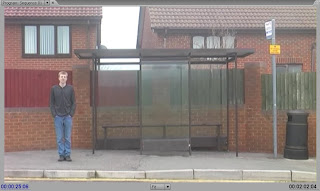
As no speech or diegetic sound is heard, the location had to be extremely focused on creating the characters representation. Also the use of teenagers as the main protagonists demonstrates a weak position in society and their heightened need for a respected social status, so using a very conflicted idea such as homosexuality would challenge this convention and set ideology and cause tension and conflict.
* Sound - as no diegetic sound was used, the non-diegetic need for a very specific and relevant piece of musical score was needed. We needed something that would reflect the mood of the protagonist subjectively, but it needed not to be corny or cheesy. We finally settled on a piece that was very emotional and matched the mood perfectly. The score we settled on defined the sbjective mood of the protagonist, whom was fragile and alone, so a gentle and solo piano piece worked perfectly. We also added non-diegetic sound clips of objects perceived to be diegetic in the situation it is placed it. For example, the use of a bus sound clip at the start signifies, through the understanding of it's iconography, the use of public transport, a lack of funds to afford a car and the representation of lower working class which helps to further define the films genre deeply within the social realism class. Another use was of a heart beat, and though it is a non-diegetic sound, because of the subjective camera angle during, the sound then becomes diegetic and creates more of an emotional response from the audience as they can hear and feel the fear and discomfort from this character. One element that was key with the music was the volume and positioning. Luckily our score quietened when it needed to and became silent, which in any film adds a heightened sense of danger or tension, but then because of it's low and bassy entrance back in, the sudden appearence of the 'stalker' on screen adds drama and excitement.
* Camera Work - to show a characters weakness or strength we really wanted to plan each camera frame instead of just relying on chance. The main character needed to be seen as weak and fragile, so camera frames were often placed above his eyeline to demonstrate domination over him, unlike the other character in which the camera needed to show a dominance FROM him, so it was placed below his eyeline.

Establishing shots were used right in the beginning to show the position of the character in a housing estate at a bus stop, a continuity need following the sound clip of the bus.
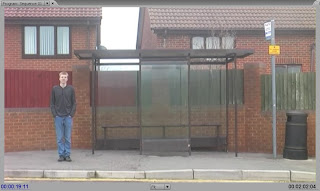
* Editing - to entice the audience further into the opening sequence, the editing cut speed grew faster and faster to build up adrenaline and tension. This went hand in hand with the score as well since it sped up slightly towards the end, this also resulted in shorter frames so the editing decisions were very precise. It also helps to enhance the mood by creating an atmosphere of fear as the main character is seen following and stalking someone else, so fear of being seen and the resulting action of being caught adds strain and unsettlement. For example, 2 different frames are cross-cut together to show the exact time between the 2 shots, because of the subjectiveity of one of them, so you can see from the main characters POV, as well as viewing him from a 3rd person perspective.
We sought to represent a particular younger generation, and the troubles they face with growing up and coming to terms with social and sexual issues. The main focus was upon the protagonist of the project, the guy whose perspective is seen more often than not, and the demonstration made was to portray is misunderstanding of his feeling towards someone of the same gender to his own. Based on the mise-en-scene surrounding the costume design and appearances, the social groups were that of modern day constructions made within the teenage generation.
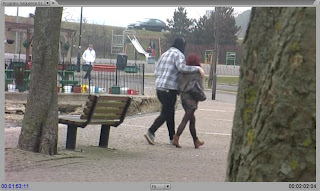
Specifically there is the 'jock' type, the muscled build and well-dressed construction, allowing the audience to understand another characters sexual desire and attractiveness towards him. This character will and is seen with another partner, allowing the audience to gain the understanding of the other characters jealousy.
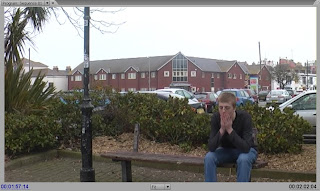
Whereas he himself is typically seen as the 'geek' type, with drab looking clothing and clumsy screen presence. He is seen as alone in every camera frame, and when he gets close to contact with his object of desire, the framing demonstrates him hiding. This establishes the contrast between the 2 characters personas and their possible attitude specifically towards an individuals sexuality giving the audience the added feeling of uncertainty and caution aimed towards the protagonist.
Because of our decision who mention the 'UK Film Councils' involvement with our project, this allows our film if created on the mass scale to be distributed to more accessible screens around the UK.
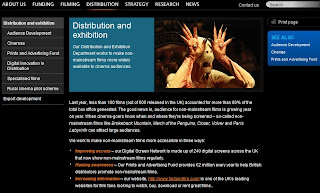
On their website, the UK Film Council state their 3 aims dedicated to non-mainstream films such as ours, an improved access to over 240 digital screens across the UK, raising awareness by funding up to £4 million a year to film distributors and increasing information on a film by previewing it on their websites. Having this media institutions support on a small film like ours would help it to reach a wider audience and obtain higher profits than it would if it was a stand alone and personally funding project. I believe that the UK Film Council would fund a film such as ours as it is set in a traditional British town and demonstrates the life of everyday British people with common troubles. I believe another reason that this film could be relatable by a UK audience would be it's involvement with a recievers 'Personal Identity' (Blulmer and Latz). Because of the lack of definable and specific identity over the 2 main characters, anyone could place themselves within that situation of unrequited love affairs and the tension and pain felt when going through such a thing. Even though the denotation is of a homosexual affair, the characters aren't built up surrounding very masculine stereotypes, so both genders can relate to the context portrayed.
The target audience of our short film would be people within the same genre to the characters within such as teenagers and young adults, as well as an older audience with more understanding and a wider knowledge of the subject and the demographic that it is based in and around. The idea of a confusion in identity is a frequent conception in a young person life, so we sought to represent this in our narrative structure. With recent protests on gay marriage and a lot of media hype about the subject, a film being released during media coverage of it would also receive greater marketing value allowing for a larger audience population to be targeted. A film such as this would not be suitable in America or anywhere global as the location is very specifically British and the subject of homosexuality is accepted in our country, whereas it may cause distress or anger in other countries world wide. Loosely based on Valdimir Propp's theory of their being 'character types' available in a narrative, representations can be fitted into our project. For example, the main protagonist can be portrayed as the hero (or victim hero) who seeks to 'marry the princess' and ultimately come out on top and win the hearts of the audience. The other male character of whom is being following can be split into 2 roles; the princess or the villain. Because of the protagonists suggested romantic feelings towards him, the idea of him being the princess of which he intends to 'wed' comes across, like he is a goal of the hero's to obtain. The villain idea is also present as he causes the hero a lot of hurt in denying him the romantic reltaionship that he desires. The underlying diegesis of these characters give the audience their own percieved representation, even though there is no diegetic sound or performance in the way of creating an identity.
Our aims to attract our target audience was to leave the opening credits as basic as possible, without giving away too much of the plot line, but keeping viewers on edge to want to find out more. By having this enigma, an excitement would be built up from the opening sequence onto the next bit of film, so the audiences attention would be captured and held. Also by using an issue that is common in the targeted generations social spectrum, this allows the general perspective to be addressed and but also giving more comprehension towards the aspect of the issue that they might not be exposed to as commonly, for example being placed subjectively as the male with the homosexual feelings. This experience is will be unknown to most audience members and by representing it in a way of establishing sympathy and empathy, a wider response will be achieved.
I have learnt a great deal about the production line surrounding the creation of a film, even one as small as ours. But specifically the technology as been the largest learning experience. From learning to correcting frame a shot to match the eyeline and subject matter, to using the Premiere Pro software to edit together our final cut. The final editing in particular was a very long and tedious process because of the very close cutting decisions we had to make as a team, through our agreements and disagreements, as well as matching it to the music and meeting the required video length.
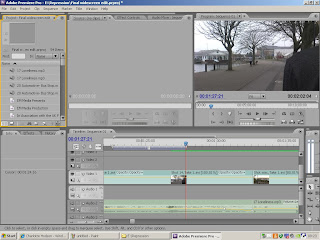
One of the main things I have learnt from the progression from the Preliminary Exercise to the Main was the vital need to organisation and preparation before undertaking ANY task, no matter how small or insignificant you may perceive it to be. For example, during the PE we didn't do a Recee before we starting filming as we just automatically thought that the room we had chosen to film in would be suitable. When it came to filming, we were all a bit put off by the size of the room but we had to work with it because of the lack of time we had to film anywhere else. This meant we could of produced a piece far more professional looking, but we didn't organise ourselves well enough. In comparison to our ME, we went out on a Recee and even took pictures of the locations we planned to shoot in to help our storyboards and keep the locations fresh in our minds as we began doing our final plans. I've also learnt a lot about the need for teamwork and group leadership, as something on a such a large scale as this project would not have been anywhere near as successful if it was done individually or one participant demanded all the work and decisions. So, whereas I was nervous working within a team for the PE, from working with them over 2 projects I have grown to respect and trust their opinions and value them over mine.
All Pre-Production work of ours can be found following these links:
* Initial Ideas
* Research ('A Way Of Life')
* 'A Way Of Life' Opening Sequence - Youtube
* Research ('Love + Hate')
* 'Love + Hate' Opening Sequence - Youtube
* Research (Typical Codes + Conventions)
* SWOT Analysis
* Storyboards
* Dual Column Script
* Risk Assessment
* Call Sheet
* Mise-En-Scene - by setting our project location in a busy and derelict looking housing estate, a representation of lower or working middle class identity was created, as also backed-up by the shoddy looking clothing. This formed the aesthetics for the mise-en-scene, so the audience could define the type of environment through their own personal socio-culture experiences and understand the demographic we are constructing.

As no speech or diegetic sound is heard, the location had to be extremely focused on creating the characters representation. Also the use of teenagers as the main protagonists demonstrates a weak position in society and their heightened need for a respected social status, so using a very conflicted idea such as homosexuality would challenge this convention and set ideology and cause tension and conflict.
* Sound - as no diegetic sound was used, the non-diegetic need for a very specific and relevant piece of musical score was needed. We needed something that would reflect the mood of the protagonist subjectively, but it needed not to be corny or cheesy. We finally settled on a piece that was very emotional and matched the mood perfectly. The score we settled on defined the sbjective mood of the protagonist, whom was fragile and alone, so a gentle and solo piano piece worked perfectly. We also added non-diegetic sound clips of objects perceived to be diegetic in the situation it is placed it. For example, the use of a bus sound clip at the start signifies, through the understanding of it's iconography, the use of public transport, a lack of funds to afford a car and the representation of lower working class which helps to further define the films genre deeply within the social realism class. Another use was of a heart beat, and though it is a non-diegetic sound, because of the subjective camera angle during, the sound then becomes diegetic and creates more of an emotional response from the audience as they can hear and feel the fear and discomfort from this character. One element that was key with the music was the volume and positioning. Luckily our score quietened when it needed to and became silent, which in any film adds a heightened sense of danger or tension, but then because of it's low and bassy entrance back in, the sudden appearence of the 'stalker' on screen adds drama and excitement.
* Camera Work - to show a characters weakness or strength we really wanted to plan each camera frame instead of just relying on chance. The main character needed to be seen as weak and fragile, so camera frames were often placed above his eyeline to demonstrate domination over him, unlike the other character in which the camera needed to show a dominance FROM him, so it was placed below his eyeline.

Establishing shots were used right in the beginning to show the position of the character in a housing estate at a bus stop, a continuity need following the sound clip of the bus.

* Editing - to entice the audience further into the opening sequence, the editing cut speed grew faster and faster to build up adrenaline and tension. This went hand in hand with the score as well since it sped up slightly towards the end, this also resulted in shorter frames so the editing decisions were very precise. It also helps to enhance the mood by creating an atmosphere of fear as the main character is seen following and stalking someone else, so fear of being seen and the resulting action of being caught adds strain and unsettlement. For example, 2 different frames are cross-cut together to show the exact time between the 2 shots, because of the subjectiveity of one of them, so you can see from the main characters POV, as well as viewing him from a 3rd person perspective.
We sought to represent a particular younger generation, and the troubles they face with growing up and coming to terms with social and sexual issues. The main focus was upon the protagonist of the project, the guy whose perspective is seen more often than not, and the demonstration made was to portray is misunderstanding of his feeling towards someone of the same gender to his own. Based on the mise-en-scene surrounding the costume design and appearances, the social groups were that of modern day constructions made within the teenage generation.

Specifically there is the 'jock' type, the muscled build and well-dressed construction, allowing the audience to understand another characters sexual desire and attractiveness towards him. This character will and is seen with another partner, allowing the audience to gain the understanding of the other characters jealousy.

Whereas he himself is typically seen as the 'geek' type, with drab looking clothing and clumsy screen presence. He is seen as alone in every camera frame, and when he gets close to contact with his object of desire, the framing demonstrates him hiding. This establishes the contrast between the 2 characters personas and their possible attitude specifically towards an individuals sexuality giving the audience the added feeling of uncertainty and caution aimed towards the protagonist.
Because of our decision who mention the 'UK Film Councils' involvement with our project, this allows our film if created on the mass scale to be distributed to more accessible screens around the UK.

On their website, the UK Film Council state their 3 aims dedicated to non-mainstream films such as ours, an improved access to over 240 digital screens across the UK, raising awareness by funding up to £4 million a year to film distributors and increasing information on a film by previewing it on their websites. Having this media institutions support on a small film like ours would help it to reach a wider audience and obtain higher profits than it would if it was a stand alone and personally funding project. I believe that the UK Film Council would fund a film such as ours as it is set in a traditional British town and demonstrates the life of everyday British people with common troubles. I believe another reason that this film could be relatable by a UK audience would be it's involvement with a recievers 'Personal Identity' (Blulmer and Latz). Because of the lack of definable and specific identity over the 2 main characters, anyone could place themselves within that situation of unrequited love affairs and the tension and pain felt when going through such a thing. Even though the denotation is of a homosexual affair, the characters aren't built up surrounding very masculine stereotypes, so both genders can relate to the context portrayed.
The target audience of our short film would be people within the same genre to the characters within such as teenagers and young adults, as well as an older audience with more understanding and a wider knowledge of the subject and the demographic that it is based in and around. The idea of a confusion in identity is a frequent conception in a young person life, so we sought to represent this in our narrative structure. With recent protests on gay marriage and a lot of media hype about the subject, a film being released during media coverage of it would also receive greater marketing value allowing for a larger audience population to be targeted. A film such as this would not be suitable in America or anywhere global as the location is very specifically British and the subject of homosexuality is accepted in our country, whereas it may cause distress or anger in other countries world wide. Loosely based on Valdimir Propp's theory of their being 'character types' available in a narrative, representations can be fitted into our project. For example, the main protagonist can be portrayed as the hero (or victim hero) who seeks to 'marry the princess' and ultimately come out on top and win the hearts of the audience. The other male character of whom is being following can be split into 2 roles; the princess or the villain. Because of the protagonists suggested romantic feelings towards him, the idea of him being the princess of which he intends to 'wed' comes across, like he is a goal of the hero's to obtain. The villain idea is also present as he causes the hero a lot of hurt in denying him the romantic reltaionship that he desires. The underlying diegesis of these characters give the audience their own percieved representation, even though there is no diegetic sound or performance in the way of creating an identity.
Our aims to attract our target audience was to leave the opening credits as basic as possible, without giving away too much of the plot line, but keeping viewers on edge to want to find out more. By having this enigma, an excitement would be built up from the opening sequence onto the next bit of film, so the audiences attention would be captured and held. Also by using an issue that is common in the targeted generations social spectrum, this allows the general perspective to be addressed and but also giving more comprehension towards the aspect of the issue that they might not be exposed to as commonly, for example being placed subjectively as the male with the homosexual feelings. This experience is will be unknown to most audience members and by representing it in a way of establishing sympathy and empathy, a wider response will be achieved.
I have learnt a great deal about the production line surrounding the creation of a film, even one as small as ours. But specifically the technology as been the largest learning experience. From learning to correcting frame a shot to match the eyeline and subject matter, to using the Premiere Pro software to edit together our final cut. The final editing in particular was a very long and tedious process because of the very close cutting decisions we had to make as a team, through our agreements and disagreements, as well as matching it to the music and meeting the required video length.

One of the main things I have learnt from the progression from the Preliminary Exercise to the Main was the vital need to organisation and preparation before undertaking ANY task, no matter how small or insignificant you may perceive it to be. For example, during the PE we didn't do a Recee before we starting filming as we just automatically thought that the room we had chosen to film in would be suitable. When it came to filming, we were all a bit put off by the size of the room but we had to work with it because of the lack of time we had to film anywhere else. This meant we could of produced a piece far more professional looking, but we didn't organise ourselves well enough. In comparison to our ME, we went out on a Recee and even took pictures of the locations we planned to shoot in to help our storyboards and keep the locations fresh in our minds as we began doing our final plans. I've also learnt a lot about the need for teamwork and group leadership, as something on a such a large scale as this project would not have been anywhere near as successful if it was done individually or one participant demanded all the work and decisions. So, whereas I was nervous working within a team for the PE, from working with them over 2 projects I have grown to respect and trust their opinions and value them over mine.
All Pre-Production work of ours can be found following these links:
* Initial Ideas
* Research ('A Way Of Life')
* 'A Way Of Life' Opening Sequence - Youtube
* Research ('Love + Hate')
* 'Love + Hate' Opening Sequence - Youtube
* Research (Typical Codes + Conventions)
* SWOT Analysis
* Storyboards
* Dual Column Script
* Risk Assessment
* Call Sheet
Subscribe to:
Comments (Atom)